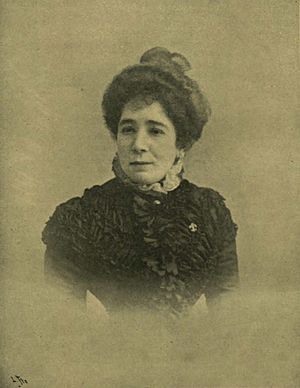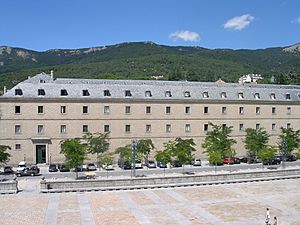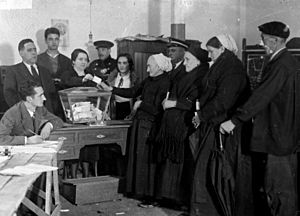Dolores Gortázar Serantes facts for kids
Quick facts for kids
Dolores Gortázar Serantes
|
|
|---|---|
|
|
|
| Born |
María Dolores de Gortázar y Serantes
1872 |
| Died | April 9, 1936 (63 or 64 years) Leganés, Spain
|
| Nationality | Spanish |
| Occupation | writer, teacher, press correspondent |
| Known for | writer |
| Political party | Carlism |
María Dolores de Gortázar Serantes (1872-1936) was a Spanish writer, journalist, and teacher. She also worked as an activist for education and women's rights. Dolores was known for her political writings and her strong Catholic faith.
In the early 1900s, she was a popular novelist. She wrote for many newspapers and magazines, and even started her own short-lived magazine for women. Dolores also helped set up schools for girls. She believed it was important for women to be active in public life, especially in education and culture. Politically, she supported the Carlists, a traditionalist movement in Spain.
Early Life and Family

Dolores Gortázar was born in León, Spain in 1872. Her family was very old and had roots in northern Spain. Her father, Carlos Gortázar y Campillo, was a journalist. He married Juliana Serantes y de Cadórniga, a woman from León.
Dolores was likely their only child. She went to a Catholic school in León and showed a talent for writing from a young age. Her poems and plays were published and performed when she was still a child.
In 1888, Dolores married Fernando Valcárcel Saavedra Fajardo Ladrón de Guevara. They lived in Mula, Spain. Sadly, her husband became ill and passed away in 1895. Dolores had one daughter, Carolina.

After her husband's death, Dolores returned to León to live with her mother. She decided to become a teacher. In 1899, she finished her teaching studies in León. She also claimed to have a doctorate in philosophy and literature.
In 1910, Dolores married Francisco Pol, a lawyer and writer. Information about this marriage is limited, but it seems they either separated or he died shortly after. Dolores faced many personal challenges throughout her life. Her daughter, Carolina, passed away in 1936, and Dolores herself died two months later. She had five grandchildren, but none became famous.
A Talented Writer
Dolores Gortázar wrote poetry throughout her life. Her poems often appeared in newspapers and magazines. They focused on Christian values, family life, the beauty of Spain, and patriotism. Her only major poetry book was Nimias (1898). She also wrote two short comedies about life in León, which were performed in León and possibly Madrid.
Dolores was first recognized for her translation work. In 1901, she translated Horace's famous poem Ars poëtica into Spanish. This translation won awards and was praised by the Real Academia Española, a very important Spanish language academy.
She also wrote historical studies, especially about old documents. She published works on San Miguel de Escalada (1899) and the Valvanera monastery (1907). She also wrote a biography of St. Frances of Rome (1911).
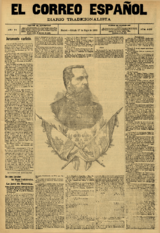
Dolores found her biggest success as a novelist. She wrote El Cristo de la roca (1911) and La roca del amor (1924). These were actually the same novel, with the second one slightly changed. The story is a romance set among wealthy families in Valencia. It's about characters overcoming challenges with their strong Christian faith.
For about 40 years, Dolores wrote for many newspapers and magazines, both in Spain and America. Some of the most important ones she worked with were El Porvenir, El Diario de Zamora, and Carlist newspapers like El Correo Español and El Cruzado Español. She also wrote for women's magazines like Gloria Femenina. In 1912, she even started her own women's magazine called Roma, which ran for two years. Her writings usually included poems, travel stories, short stories, and articles about culture and education, all with a Catholic viewpoint.
Teacher and Activist
In 1902, Dolores began teaching at a state college in Madrid. That same year, she proposed opening a school for poor and disabled children. By 1904, this idea changed into a high-quality school for middle-class girls. The queen mother, Maria Christina, was a supporter of the project.
In 1905, the school became the Centro Nacional de Instrucción de María Cristina, with Dolores as its director. In 1906, the Escuela María Cristina opened. It was praised as a modern school, even including cooking lessons in its curriculum.
By 1908, Dolores left the school and returned to León. She became a provisional teacher at the Escuela Normal de Maestras in León. In 1909, she was appointed to a similar position in Soria. However, her teaching career was cut short. In 1910, she was accused of misusing her power and was fired. Dolores claimed her problems were due to changes in government rules. This event seemed to end her official teaching career, but she continued to be involved in opening schools for working-class people in Covadonga (1914) and Madrid (1918).
From the 1910s onwards, Dolores was very active in many organizations. These groups focused on women's issues, Catholicism, education, and social work. She helped start the Fundación San Francisco de Paula in 1910. In the mid-1910s, she led Acción Social Católica Feminista, a Catholic women's social action group. She also worked with La Mujer Católica and campaigned for hygiene and health in the 1920s.
In 1927, she helped launch Cruzada de Buenas Lecturas (Crusade for Good Reading), an organization that promoted good books. She was its president until the early 1930s. In 1931, she co-founded Club Feminista and became president of Sociedad Femenina Aspiraciones. In 1932, she became president of Agrupación Femenina Paz Social. She also gave many lectures on cultural topics and was a member of the Association of Spanish Writers and Artists. Dolores became a strong supporter of female suffrage, campaigning for women's right to vote between 1931 and 1933.
Carlist Supporter
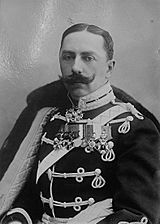
Even though her father was a Liberal, Dolores became a strong supporter of Traditionalism and the Carlist movement in the 1890s. At first, she organized prayers and donations for the Spanish army. By 1899, she was involved in artistic events for the Carlist group in León. She also started writing for El Correo Español, a Carlist newspaper. By 1900, she was known as an "illustrious Carlist lady."
In 1902, the Carlist heir, Don Jaime, sent her a congratulatory letter for her translation of Horace. This was unusual because he wasn't particularly interested in literature.
Her Carlist activities became even stronger after 1919. She wrote an article praising loyalty to the king. In 1920, she attended many Carlist meetings. In 1921, she became president of the Madrid Margaritas, the Carlist women's organization. That same year, she took part in a big Carlist meeting in Lourdes and published a pamphlet supporting the Carlist program.
When the newspaper El Correo Español closed, Dolores started writing for other conservative newspapers. She was proud of her friendship with Don Jaime and called him "our leader." She also worked closely with a new Carlist weekly newspaper, El Cruzado Español, hoping to turn it into a daily. She received a high Carlist honor called the Ordén de la Legitimidad Proscrita.
During the late 1920s and early 1930s, she became more active. She opened new Carlist centers, appeared in headlines, and led the Madrid Margaritas. She worked to mobilize people against what she called "great privileges for red women," especially after the Republic was declared. In the first years of the Republic, she remained active in the Carlist movement, contributing to Cruzado and giving lectures. From 1933, she was the honorary president of the Madrid Carlist center, and in 1935, she helped with election campaigns.
See also
 In Spanish: Dolores de Gortázar para niños
In Spanish: Dolores de Gortázar para niños
- Carlism
- Real Centro Universitario Escorial-Maria Christina
- El Cruzado Español


